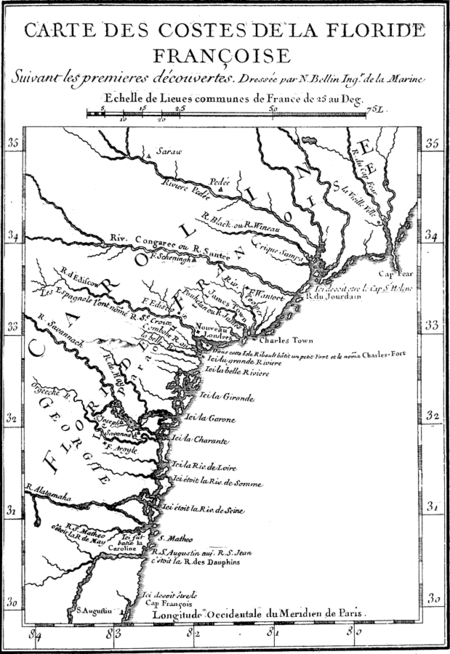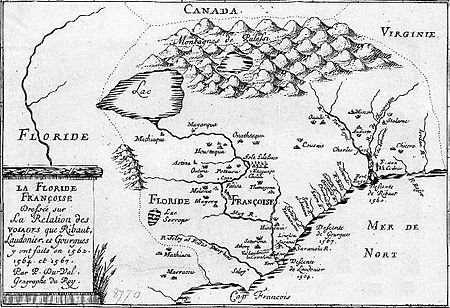Charlesfort-Santa Elena Site facts for kids
|
Charlesfort-Santa Elena Site
|
|
| Lua error in Module:Location_map at line 420: attempt to index field 'wikibase' (a nil value). | |
| Nearest city | Beaufort, South Carolina |
|---|---|
| Built | 1562 |
| NRHP reference No. | 74001822 |
Quick facts for kids Significant dates |
|
| Added to NRHP | August 7, 1974 |
| Designated NHL | January 3, 2001 |
The Charlesfort-Santa Elena Site is a very important historical place on Parris Island, South Carolina. It's where archaeologists find clues about early settlements. This site holds the remains of two old settlements: Charlesfort, built by the French in 1562, and Santa Elena, built by the Spanish later in the 1500s.
The Spanish built a fort right on top of the abandoned French Charlesfort. This fort and other buildings nearby were known by different names, like Fort San Marcos and Fort San Felipe. Because these sites are so well-preserved and teach us a lot about early French and Spanish life in America, the area became a National Historic Landmark in 2001. You can visit this site through the United States Marine Corps Recruit Depot in Port Royal, South Carolina.
Contents
Charlesfort: A French Adventure (1562–1563)
Charlesfort was started by a French group led by Jean Ribault in 1562. They landed near the May River in February and then moved north to Port Royal Sound. On what is now Parris Island, South Carolina, Ribault left 28 men to build a settlement. He planned to go back to France for more supplies.
However, Ribault was arrested in England because of problems in France. This stopped him from returning to the new colony. After he left, many of the settlers' supplies burned. Their leader, Captain Albert de la Pierria, died during a disagreement, possibly because he was too strict. Without supplies or a strong leader, and facing problems with the local Native Americans, almost all the colonists left after only one year. They built their own boat and sailed across the Atlantic Ocean without a compass. An English ship rescued them, and some eventually made it back to France.
Soon after the French left, a Spanish force from Cuba, led by Hernando de Manrique de Rojas, destroyed the empty French fort. They also captured the one Frenchman who had stayed behind with the local Native Americans.
In 1577, when the Spanish settlement was gone, the French tried to return. Nicholas Strozzi led an expedition on the ship Le Prince. The ship was lost as they entered Port Royal Sound. The men built a new triangular fort with five buildings. Many of them were killed by Native Americans. The Spanish returned in 1578 and captured the remaining Frenchmen from the Native Americans. Most of these captives were later executed.
Santa Elena: A Spanish Capital (1566–1587)
Santa Elena was founded in 1566 on the same spot as Charlesfort. It became the first capital of Spanish Florida. First, a simple fort called Fort San Salvador was built. Then, Fort San Felipe was built directly on top of the old French fort that same year. They even dug a new moat around it. This fort was used until 1570, when it was destroyed by fire.
The Spanish then built a second Fort San Felipe nearby, but its exact location is unknown. The fort and town were left empty in 1576, partly because of conflicts with the local Native Americans.
In 1577, the Spanish came back and built Fort San Marcos. This fort was used until 1582 or 1583, when a second Fort San Marcos was built. In 1586, a moat was dug around this new fort because they expected an attack from Sir Francis Drake. Santa Elena and its forts were finally abandoned in 1587. At its busiest, the town had about 60 homes and an estimated population of 400 to 450 people.
Finding History: Archaeology at the Site
People first realized this area was important for archaeology in the mid-1800s. Amateurs found what they thought was Charlesfort and dug up large metal hinges, like those from a big gate. In 1917, some of the earth walls from the first Fort San Felipe were flattened by Marine Corps workers, which filled in part of the moat. In the 1920s, Major George Osterhout led a dig at the site. He believed it was Charlesfort, and a memorial marker was placed there.
However, Osterhout's idea was soon questioned. By the 1950s, most archaeologists thought the site was part of Spanish Santa Elena. It took many more digs, from the 1970s to the 1990s, to fully understand the history and layout of the area. Archaeologists could finally find the French fort because they found unique French items only in certain spots. They also found proof that several moats had been dug around the first Fort San Marcos.
This site is incredibly important for understanding the early history of North America and South Carolina. It shows the early competition between countries to control this region. Archaeologists also found the only known early Spanish pottery oven on the continent here. Because the area was never used for farming, even small items on the surface can still be found today.
See also




